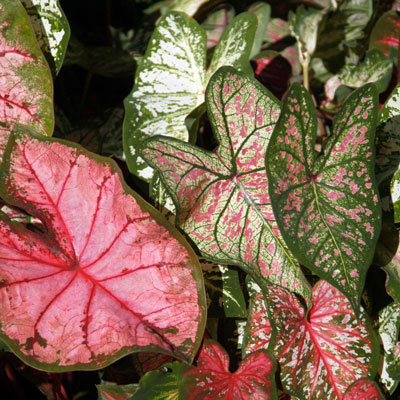Questions of the Week: November 10, 2016
Here is a collection of four questions I’ve been answering almost daily lately.
“Should I trim my bougainvillea and hibiscus plants back before I put them into the garage for the winter?”
Yes. Reshape them into more manageable form before you try to bring them inside. But, no for the garage. Garages are usually too dark and too cold for tropicals to survive. If you’re able to put the plants on plant dollies and move them in and out on warm days, that would help. Otherwise, a sunroom or greenhouse would be highly preferable. Or, as many of us do, treat them as annuals and replace them next year.

Photo: Can caladiums survive the winter out in your landscape?
“How should I handle my caladiums over the winter?”
Most gardeners try saving their caladium tubers. They do so one time, then they decide that the effort is too great and the rewards are far too small. If you want to give it a go, allow their tops to die naturally, then dig them before a hard freeze and lay them on newspapers in the garage. Let them dry for a couple of days, then place them in shallow boxes filled with dry sawdust or perlite. Dust them with sulfur, making sure no two of the tubers touch one another. Store them at 65 degrees indoors, and wait until mid-April to plant them into the ground again.
“When can I safely move a couple of trees and shrubs in my landscape?”
Wait until the plants have been exposed to one or more hard freezes. That puts them into complete dormancy, and that’s critical to transplanting success. Dig them with a firm ball of soil intact around their roots, and replant them immediately. Thin them to compensate for roots lost in the process, and apply a liquid root-stimulator fertilizer. Keep them moist at all times.
* * *

Photo: Wonder how best to succeed with pansies and violas?
“What are the secrets to growing pansies? Mine usually wilt and die before they come into good bloom.”
Start with healthy, vigorous transplants. Set them into raised beds that will always drain perfectly and quickly during periods of wet weather. Incorporate 5 or 6 inches of organic matter (a blend of equal parts of well-rotted compost, pine bark, sphagnum peat moss, rotted manure) and 1 inch of expanded shale. Rototill to blend it all to a depth of 12 inches, and rake to a rounded crown. Space the plants on 12-inch centers, and water them immediately after planting. Apply a high-nitrogen, water-soluble plant food each time that you water them thereafter.
